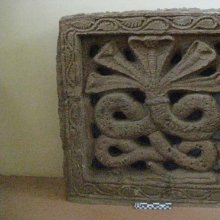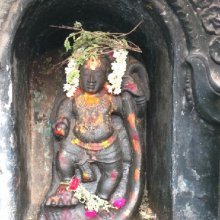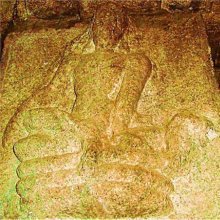Snake: 4 definitions
Introduction:
Snake means something in Buddhism, Pali, Hinduism, Sanskrit. If you want to know the exact meaning, history, etymology or English translation of this term then check out the descriptions on this page. Add your comment or reference to a book if you want to contribute to this summary article.
Images (photo gallery)
(+51 more images available)
In Hinduism
Yoga (school of philosophy)
Source: ORA: Amanaska (king of all yogas): A Critical Edition and Annotated Translation by Jason BirchSnake (in Sanskrit: Bhujaga) cannot hurt those students of Yoga who have practiced for at least three years, allowing them to to attain the Siddhis (of the best of Sages), according to the Śivayogadīpikā, an ancient Sanskrit text dealing with Yoga possibly corresponding to the Śivayoga quoted in Śivānanda’s Yogacintāmaṇi.—Accordingly, [while describing a sequence of Haṭhayoga practices]: “Thus, by means of this Haṭhayoga which has eight auxiliaries, those [students who are] life-long celibates obtain the Siddhis of the [best of Sages] because of their untiring practice. [...] Then, in the third year, he is not hurt by noxious [animals] such as snakes (bhujaga). In the fourth year, he is free from [any] torment, thirst, sleep, cold and heat. In the fifth year, he has clairaudience, the Siddhi of speech and [the power to] enter the bodies of other [beings]. [...]”

Yoga is originally considered a branch of Hindu philosophy (astika), but both ancient and modern Yoga combine the physical, mental and spiritual. Yoga teaches various physical techniques also known as āsanas (postures), used for various purposes (eg., meditation, contemplation, relaxation).
Natyashastra (theatrics and dramaturgy)
Source: Shodhganga: Elements of Art and Architecture in the Trtiyakhanda of the Visnudharmottarapurana (natya)Snakes (or Serpents) are denoted by the Sanskrit term Uraga, whereas Uragaśīrṣa-hasta refers to one of the twenty-two Single-hand Gestures (in Indian Dramas) (known as asaṃyuktahastas), according to the Viṣṇudharmottarapurāṇa, an ancient Sanskrit text which (being encyclopedic in nature) deals with a variety of cultural topics such as arts, architecture, music, grammar and astronomy.—The name of the uragaśīrṣa-hasta posture itself identifies that the hand posture should look like the head of an uraga i.e., a serpent. In this posture the thumb should be in clinching form and the middle part should remain hollow. According to Abhinavagupta, this posture looks like the head of a snake and that is why this posture is named as uragaśīrṣa.

Natyashastra (नाट्यशास्त्र, nāṭyaśāstra) refers to both the ancient Indian tradition (shastra) of performing arts, (natya—theatrics, drama, dance, music), as well as the name of a Sanskrit work dealing with these subjects. It also teaches the rules for composing Dramatic plays (nataka), construction and performance of Theater, and Poetic works (kavya).
Pancaratra (worship of Nārāyaṇa)
Source: Shodhganga: Kasyapa Samhita—Text on Visha Chikitsa (p)Snakes are known in the Sanskrit language as Nāga or Sarpa.—The snake is the unncaniest of all animals. It is the deadly poison of some snakes that causes the whole species to be dreaded. The word sarpa is so-called because of its slithering movements, inspires wonder and panic in one’s psyche. Nāgas are referred to as a class of semi-divine beings with bodies half -man and half-snake and grouped along with Kinnaras, Yakṣas, Gandharvas etc. The Sanatkumāra Saṃhitā (III.36cd-37ab) states that snakes are of two kinds, Nāgas and Sarpas. While the former can take any form they desire, the latter are those which glide. Snakes are said to reside in Nāgaloka which is located in the endless bowels of the earth with countless palaces, houses and towers, it is also known as pātālaloka. Lord Brahmā allocated specific regions for snakes to dwell, such as Pātāla, Vitala and Harmya.

Pancaratra (पाञ्चरात्र, pāñcarātra) represents a tradition of Hinduism where Narayana is revered and worshipped. Closeley related to Vaishnavism, the Pancaratra literature includes various Agamas and tantras incorporating many Vaishnava philosophies.
In Buddhism
Tibetan Buddhism (Vajrayana or tantric Buddhism)
Source: academia.edu: The Structure and Meanings of the Heruka MaṇḍalaThe Snake is associated with the Yoginī (female deity) named Vyāḍā, being situated in the Medinīcakra, according to the 10th century Ḍākārṇava-tantra: one of the last Tibetan Tantric scriptures belonging to the Buddhist Saṃvara tradition consisting of 51 chapters.—Accordingly, the medinīcakra refers to one of the three divisions of the dharma-puṭa (‘dharma layer’), situated in the Herukamaṇḍala. The 36 pairs of Ḍākinīs [viz., Vyāḍā] and Vīras are yellow in color; the shapes of their faces are in accordance with their names [e.g., Snake]; they have four arms; they hold a skull bowl, a skull staff, a small drum, and a knife.

Tibetan Buddhism includes schools such as Nyingma, Kadampa, Kagyu and Gelug. Their primary canon of literature is divided in two broad categories: The Kangyur, which consists of Buddha’s words, and the Tengyur, which includes commentaries from various sources. Esotericism and tantra techniques (vajrayāna) are collected indepently.
See also (Relevant definitions)
Starts with (+21): Snake aloe, Snake bean tree, Snake broom, Snake bryony, Snake climber, Snake flower, Snake gourd, Snake grass, Snake lily, Snake palm, Snake plant, Snake poison, Snake root, Snake rope, Snake selaginella, Snake skin, Snake tongue, Snake tree, Snake vine, Snake weed.
Ends with: Blue rattlesnake, Coiled snake, Snake skin, White blotched rattlesnake.
Full-text (+3613): Sarpa, Ahi, Pannaga, Uraga, Vyala, Bhujaga, Vishadhara, Phani, Gonasa, Naga, Vasuki, Pridaku, Vishamantra, Bhogin, Sarpamani, Darvikara, Ahitundika, Dvijihva, Bhujanga, Phanadhara.
Relevant text
Search found 326 books and stories containing Snake; (plurals include: Snakes). You can also click to the full overview containing English textual excerpts. Below are direct links for the most relevant articles:
Sushruta Samhita, Volume 5: Kalpasthana (by Kaviraj Kunja Lal Bhishagratna)
Chapter IV - Description of the poison of a snakebite
Chapter V - The medical treatment of snake bites
Mahabharata (English) (by Kisari Mohan Ganguli)
Amarakoshodghatana of Kshirasvamin (study) (by A. Yamuna Devi)
Fauna (6): Snakes < [Chapter 5 - Aspects of Nature]
Fauna (10): Miscellaneous information relating to Fauna < [Chapter 5 - Aspects of Nature]
Fauna (1): Information on Fauna (Animal Kingdom) < [Chapter 5 - Aspects of Nature]
The Book of Protection (by Piyadassi Thera)
Discourse 5 - Protection Of The Aggregates < [Discourses]
The Jataka tales [English], Volume 1-6 (by Robert Chalmers)
Jataka 203: Khandha-Vatta-jātaka < [Book II - Dukanipāta]
Jataka 518: Paṇḍara-jātaka < [Volume 5]
Jataka 412: Koṭisimbali-jātaka < [Volume 3]
Related products
(+16 more products available)









